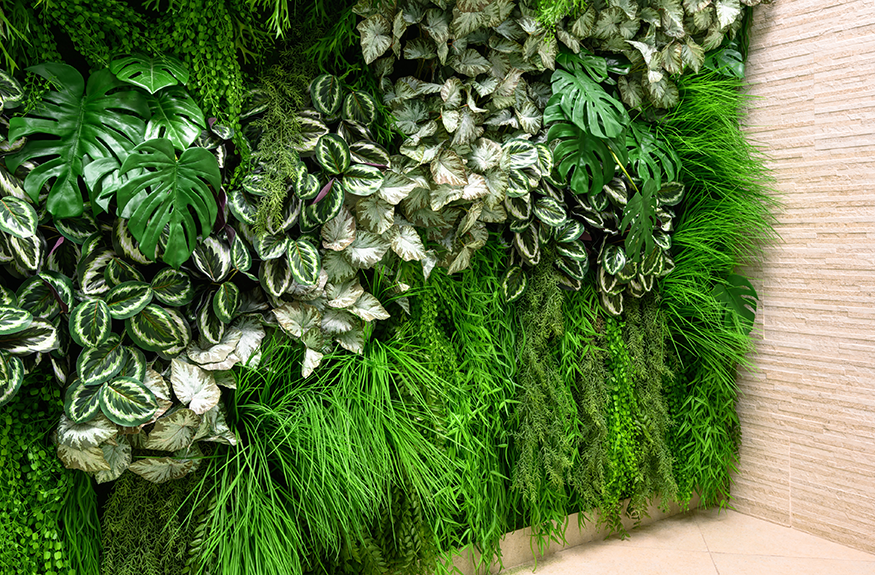Native Landscaping in Commercial Real Estate
In Commercial Real Estate, landscape design is incredibly important to the overall look and feel of a property. Utilizing native landscaping is a great way reduce overall maintenance costs and water usage while simultaneously providing habitats for pollinators and other native species.
A few non-native species regularly used in landscaping are ornamental grasses like Fescue grass, Kentucky Blue grass, Bermuda grass, and more. If these ornamental grasses are replaced with native species, the need for fertilizers, pesticides, and overall maintenance decreases significantly. Native landscaping provides numerous benefits to commercial real estate, here’s how.
Biodiversity
Native landscaping benefits other native species like pollinators and helps to maintain native ecosystems and biodiversity. Pollinators, like bees and butterflies, are incredibility important to our ecosystems across the globe, and planting native species helps recover and maintain pollinators in our communities.
Other wildlife such as birds and small mammals benefit from native plants as food sources and shelter. Birds and native plants have a symbiotic relationship as native species provide nourishment and protection from predators and weather, and the birds help to pollinate and spread the plants seeds.
In the Southeastern region of the United States, Wood-Storks, Chuck-Will’s-Widows, and Swainson’s Warblers are a few native bird species. In the Southwestern United States, California Condors, Brown-Capped Finches, and Black Rosy-Finches are common.
Cost
Cost and maintenance are major factors in landscaping design. With native landscaping, plants require less maintenance in terms of soil and water and are more persistent through inclement weather conditions. After initial instillation, native plants are inexpensive to maintain since they are acclimated to survive in their own environment.
Native landscaping and native plants are also more likely to thrive in their environment, reducing the risk of having to replant and the associated costs. Reduced maintenance on a landscape directly translates to reduced labor costs as well.
Executive Director of the Georgia Urban Agriculture Council, Mary Kay Woodworth states that property managers and owners “recognize that they’ve got to have a low maintenance landscape and have less inputs on the landscape.”
Less inputs on a landscape means reduced maintenance costs. Inputs on a landscape can include anything used to maintain a landscape such as pesticides, fertilizers, irrigation systems, machinery, and more.
Irrigation
Native plants have adapted to their native climate over countless generations, allowing them to be expertly suited for beneficial irrigation. Native landscaping can help mitigate flooding at commercial properties due to the water retention of native plants in their natural climate. For building owners and managers, native landscaping can reduce flood risk while maintaining an aesthetically pleasing design. Avoiding excess flooding also improves the quality of life for tenants and visitors and can lower insurance premiums and repair costs.
“Water management is something that really makes a big difference because it’s not just about watering your lawn. It’s all about the stormwater runoff and pesticide use and things like that” explains Woodworth.
Native plants in landscaping design make irrigation systems easier to maintain because they are more drought-tolerant than non-native plants. Native plants also allow for the integration of the landscaping practice called xeriscaping, where little or no irrigation is used to maintain a landscape.
Attractiveness
Aesthetically appealing landscaping can attract tenants to certain properties. A study at the University of Sheffield, UK found that there is a strong correlation between the perceived attractiveness and the perceived benefits to insects.
“Results indicate a positive relationship between how attractive our participants perceived the planting to be and their perception of its benefits for butterflies, bees and other insects” claims authors, Hoyle, Hitchmough, and Jorgensen.
When a tenant finds a property landscape attractive, they are more likely to think it is ecologically beneficial.
Xeriscaping
Xeriscaping is a form of landscaping that requires little to no irrigation. This system helps reduce costs associated with installation and maintenance of plants and irrigation systems.
Xeriscaping utilizes drought-tolerant plants like succulents and native plants. Xeriscaping increases the use of native plants and decreases the need for excess water. This method of landscaping is ecologically and economically benefits in commercial properties.
Impact and Benefits
Ecological health is an important factor for some tenants when comparing various properties and lush native landscapes are a great selling point. Native landscaping reduces costs in labor and water, lowers environmental impact, and reduces the need for expensive irrigation systems. Native plants thrive in their indigenous climate and can create a vibrant landscape that appeals to potential tenants while simultaneously saving money and being environmentally beneficial.
To find native plants in your area try using the National Wildlife Federation’s Plant Finder.
To stay up to date on news and resources such as this and other topics of importance to the real estate industry, subscribe to the free CRE Insight Journal Newsletter using this link.
Sources:
- Mary Kay Woodworth, Executive Director of the Georgia Urban Agriculture Council
- Commercial Real Estate and Landscape Design (completelandscapingservice.com)
- Native Landscaping for Biodiversity | BuildingGreen
- All about the ‘wow factor’? The relationships between aesthetics, restorative effect and perceived biodiversity in designed urban planting – ScienceDirect
- 5 Benefits of Using Native Plants For A Sustainable Landscape | Bluegrass Lawncare
- The 12 Most Common Grass Types for Lawns (yourgreenpal.com)
- Birding by Region » Bird Watcher’s Digest (birdwatchersdigest.com)









